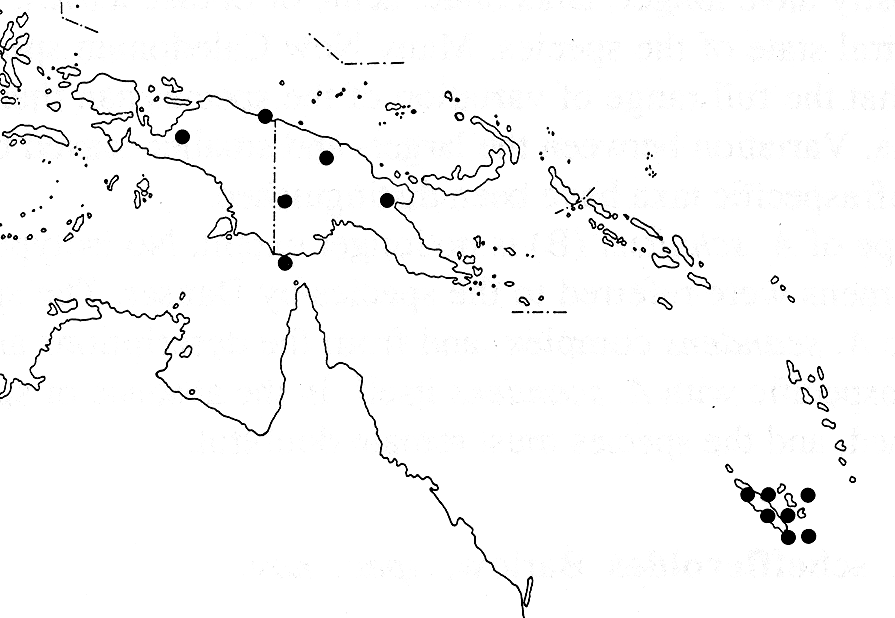
Distribution Map

Description (Barlow 1992)
Neophylum scandens Tieghem,
Bull. Soc. Bot. France 41 (1894) 509. - Amyema scandens (Tieghem)
Danser, Bull. Jard. Bot. Buitenzorg III, 10 (1929) 299. - Type:
Balansa 498 (holo P; iso P), New Caledonia, Prony Bay,
ix.1868.
Doubtful species provisionally included here:
Loranthus schultzei Krause, Bot. Jahrb. Syst. 57 (1922) 478. - Amyema schultzei (Krause) Danser, Bull. Jard. Bot. Buitenzorg III, 10 (1929) 299. - Type: Schultze 305 (B, not extant), New Guinea, Sepik R., bivouac 48.
For descriptions and extensive further synonymy see Danser, Bull. Jard. Bot. Buitenzorg III, 11 (1931) 354, under A. verticillifolia; ibid. 14 (1936) 92; Barlow; Austral. J. Bot. 22 (1974) 583. The following taxa are excluded from this synonymy: Loranthus caudiciflorus, L. gigantifolius, L. plicatulus, Amyema cephalanthera, A. duurenii, A. ovariosa, and A. scandens subsp. crassifolia.
The species description by Barlow (1974)
is amended as follows: Glabrous or rarely the inflorescence and
flowers shortly and sparsely tomentose. Stems usually robust
and distinctly lenticellate, enlarged at the nodes, terete. Leaves
verticillate, mostly in whorls of 5-8, rarely quaternate;
lamina very variable, lanceolate to ovate or rarely broadly ovate
or obovate, 5-20 cm long, 2.5-7 cm wide, thinly to thickly coriaceous,
dull on both sides or with the upper surface somewhat glossy,
attenuate, cuneate or rarely truncate at the base into a petiole
3-10(-15) mm long, sometimes undulate at the margin, mostly acute
or obtuse or less often rounded at the apex; venation pennate,
mostly obscure except for the midrib which is raised below. Inflorescences
several at the nodes and often on the epicortical runners;
peduncle 6-12 (-30) mm long, 0.8-1.5 mm thick; rays 4-8, (3-)4-10
mm long; flowers all sessile in the mads; bracts triangular, c.
1 mm long, rounded at the apex, forming a small spreading involucre
below the mads. Ovary funnel- to barrel-shaped, 2-3 mm
long; calyx limb truncate, 0.5-1 mm long, erect or slightly funnel-shaped.
Corolla in the mature bud slender, (20-)25-40 mm long,
usually acute or shortly rounded, 5- or 6-merous. Anther (2.5-)3-4
mm long, usually about one third as long as the free part of the
filament. Stigma knob-like, about 1.5 times wider than
the style. Fruit ellipsoid to obovoid, 7-10 mm long, crowned
by the calyx limb and often by long persistent styles.
Amyema scandens is recorded from New Guinea and New Caledonia
(including Lifu and Isle of Pines) (fig. 14; 105 collections seen),
at elevations from sea level to 1600 m. The species occurs in
primary and secondary rain forest and open humid forests, parasitic
on a wide range of hosts including Calophyllum, Eugenia, Garcinia,
Nothofagus, and Terminalia.
The Amyema scandens species complex can be identified
in the Papuasian region by the inflorescence of a 4- to 8-rayed
umbel of triads with all flowers closely sessile in an equidistant
arrangement. In addition to A. scandens, the complex includes
A. arthrocaula, A. canaliculata, A. caudiciflora, A. cercidioides,
A.friesiana, A. plicatula, and A. triantha. For further
discussion on the two species accepted here as A. caudiciflora
and A. plicatula, see notes under those species. Within
the complex A. scandens can be identified by its leaves,
which are verticillate and mostly in whorls of 5-8 (rarely quaternate),
petiolate, flat, and mostly lanceolate to ovate. The corolla is
consistently described as red, in shades ranging from pale to
dark and from bright to dull.
The Amyema scandens complex is centred in New Guinea, and
extends southeastwards to Australia and New Caledonia. To the
west, its occurrence in Borneo represents a significant disjunction
(see note under A. triantha). Half of the species in the
complex are relatively localized in New Guinea and are apparently
young endemics which have differentiated from the major more continuous
body of variation as the rapid evolution of landforms created
a greater diversity of niches to be occupied. They differ primarily
in vegetative characters including phyllotaxy, petiole development,
and leaf shape and texture. Apart from the triads of sessile flowers,
the species have few specialized characters, and thus present
a relatively generalized facies for the genus. As a whole, the
complex appears to comprise vigorous robust biotypes which have
occupied a range of habitats, and from a lowland base have reached
some remote localities.
Amyema scandens itself has become the most abundant loranth
in New Caledonia, presumably reaching there by dispersal from
New Guinea. The most common biotype in New Caledonia is one with
relatively small, ovate, rounded leaves 7-10 cm long, suggesting
that some local differentiation has taken place. The New Guinean
specimens mostly have longer, lanceolate, acute or obtuse leaves,
which may represent the ancestral state of the species. Many New
Caledonian specimens also show this state, so that the full range
of variation of the species can therefore be found in New Caledonia.
Variation between the larger- and smaller-leaved biotypes is continuous
and no infraspecific taxa have been distinguished.
The holotype of A. schultzei (B) is no longer extant No
isotypes are known, and no other specimens were referred to the
species by Danser. The species is clearly a member of the A.
scandens complex, and from the descriptions and illustration
appears to be con specific with A. scandens itself. In
the absence of specimens this cannot be confirmed, and the species
must remain doubtful.
Distribution Map (Barlow 1974)
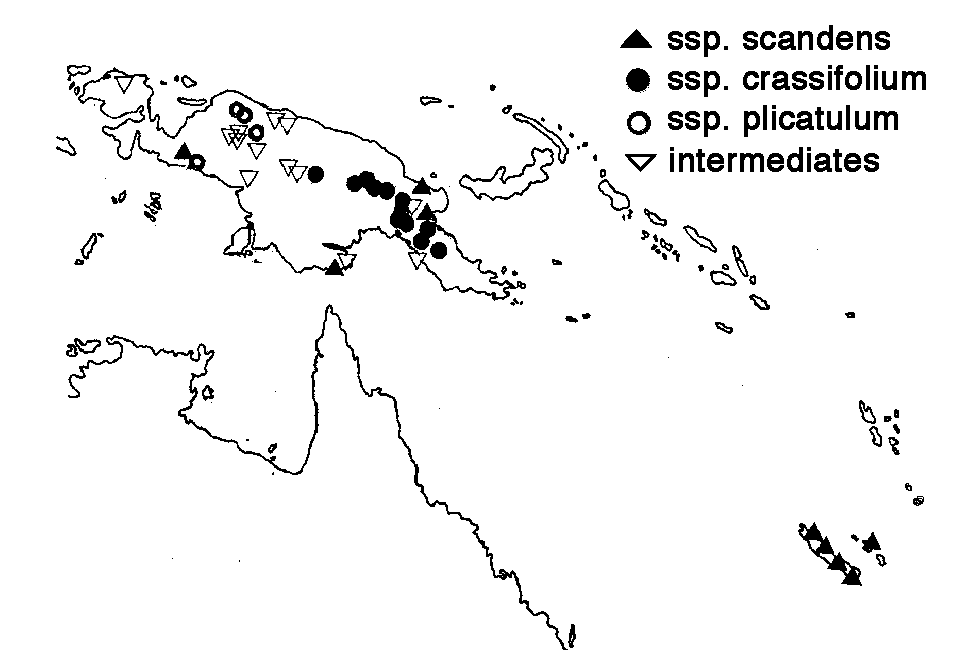
Description (Barlow 1974)
Glabrous or with the calyx very shortly and sparsely brown- or white-tomentose. Stems rohust, often conspicuously lenticellate. Leaves usually verticillate with 3-4-(8) leaves in the whorl, sometimes opposite; petiole ahsent or up to 2 cm long; lamina very variahle, narrow lanceolate to hroadly ovate, 8-20-(30) by (1.5) - 4- 6-(15) cm, thick or thin, sometimes undulate, attenuate to slightly cordate at the base, acute and shortly mucronate to rounded at the apex; venation always pennate, distinct or obscure. Inflorescences few to several at the nodes or on the runners; peduncle (1)-5-25 mm long; rays 5-8, 6-10 mm long; triads with all flowers sessile; hracts spreading, rounded, 1-2 5 mm long, shortly united at the margins into an involucre under each triad. Calyx cylindrical funnel-shaped or barrel-shaped; limb erect, truncate or weakly toothed, 07-1 3 mm long. Corolla in the mature hud slender, sometimes clavate, acute or ohtuse, 20-30-(38) mm long, 5- or 6-merous. Anthers 1-2.5 mm long; free parts of the filaments 5-6 times as long. Stigma knob-like, about 1.5 times as wide as the style.
Occurrence. New Guinea, New Caledonia and New Hebrides
(Fig. 3), sea level to 2500 in altitude.
Amyema scandens is at the core of a complex within which
there is a great deal of variation, and in which it is very difficult
to recognize limits of species. Some of the extreme variants have
been circumscribed as distinct species (A. angulare, A. canaliculatum,
A. cercidioides, A. obovarum and A. pentactis). Each
of these is based only on a single collection, and their
constancy is therefore not known. However, each of these segregates
occurs within the range of A. scandens, and is sharply
distinct from material of A. scandens from the same area.
The widespread species A. friesianum is probably also close
to the A. scandens complex.
Within the polymorphic Amyema scandens three distinct forms
may be distinguished, and because these are geographically discrete
and apparently allopatric they have been treated as subspecies.
Many specimens have been examined that have characters intermediate
between two subspecies, or that resemble one subspecies but show
a trend towards another. The intermediates, in fact, constitute
the largest single group of specimens distinguished. Because of
these strong indications of hybridization andlor clinal variation,
it appears that there is no effective reproductive isolation between
the entities recognized, and it does not seem appropriate to accord
them specific status.
Key to Subspecies of Amyema scandens
1. Leaves distinctly petiolate, 7-15
cm long 2
1. Leaves sessile or nearly so, 9-25 cm long. Leaves usually regularly
quaternate 23b. Subsp.
crassifolium
2. Leaves scattered-ternate, elliptical
to ovate, rounded at the apex 23c.
Subsp. plicatulum
2. Leaves usually in regular whorls
of 4-8, lanceolate to oblong, acute to rounded at the apex but
usually with a small mucro 23a.
Subsp. scandens
23a. Subsp. scandens
Synonyms: all names listed in synonymy
under Amyema scandens with the following epithets: scandens
Tiegh., rotundifolium Tiegh., vieillardii Tiegh.,
grandifolium Tiegh., pancheri Tiegh. lanceolatum
Tiegh., luteum Tiegh., acutifolium Tiegh., rubrum
Tiegh., fatifolium Tiegh., baudouinii Tiegh.,
lanceolatifolius EngI., neocaledonicus Schlecht.,
pustulatus S. Moore, glaucescens S. Moore, angustiflorus
S. Moore and verticillifolia Krause. Illus. Dans. Bull.
Jard. bot. Buitenz. 11: 343, Fig. 11, 1-n.
Leaves in regular or slightly scattered whorls of 4-8; petiole distinct, more or less terete, 05-2 cm long; lamina lanceolate to oblong, 7-15 by 2.5-3.5-(4.5) cm, attenuate at the base, acute obtuse or rounded at the apex but usually with a small mucro; venation pennate with the midrib distinct on both sides and raised below and the other venation obscure. Infiorescences slender; peduncle c. 15 mm long. Calyx slightly funnel-shaped. Corolla 30-38 mm long.
Occurrence. New Caledonia, Isle of Pines, Island Lifu and New Hebrides (Fig. 3), up to 1100 m altitude. Also recorded from four widely separated localities in New Guinea (Fig. 3), sea level to 260 in altitude.
Representative Specimens. WEST IRIAN: Wissel Lakes region, biv. Praun to Poero, trip from post to Boebeiro, Fyma 5433, Oct. 1939 (L). EASTERN NEW GUINEA: Penzara, between Morehead and Wassi-Kussa Rs., Western Div., Brass 8345, Dec. 1936 (CANB; L); Oomsis logging area, 260 m alt., Henty NGF 13694, Sept. 1961 (CANB; L). NEW CALEDONIA: R. Blanche, c. 30 miles E. of Noumea 200 m alt., McMillan 5126, 21.vii.1952 (L); Mt. Mou, 1050 m alt., MeMillan 5010, 26.vi.1952 (L); Mt. Dior, lower slopes, Chambers 2796, Aug. 1963 (AD); Plaine des Lacs, McKee 2375, 9.iv.1955 (L). NEW HEBRIDES: Ipota, Eromanga, Bernardi 13188 (L).
Amyema scandens subsp. scandens and Amylotheca pyramidata have been reported in New Caledonia by several authors to grow independently in the soil before becoming parasitic on the host (cf. Menzies and McKee 1959, in which the habit of the specimen McKee 2375 is described in some detail). Unfortunately no details are known about the growth and development of the root system. The situation may in fact be comparable with that in Gaiadendron punctatum (R. & P.) G. Don (Kuijt 1963, 1964). In that species, a plant may grow epiphytically or as a terrestrial shrub or tree. The terrestrial stage may occur secondarily when a plant growing aerially spreads down the host and reaches the ground.
23b. Subsp. crassifolium
Barlow, subsp. nov.
Type-New Guinea,
Western Highlands, Lagaip Valley, Kepilam Village, c. 2480
m alt., Hoogland and Schodde 7243, 30.vii. 1960 (CANB 84223,
holotype; L 96120366).
Rami robustissimi, juniores conspicue lenticellati.
Folia pleruinque regulatim quaternata (raro dissita); lamina crassa,
late lanceolata vel elliptica, 10-25 cm longa, 3.5-10 cm lata,
apice acuta vel rotundata, costa infra prominenti cetero obscuro,
basi in petiolum crassum teresque 0-3 mm longum contracta. Inflorescentiae
aliquot vel multae in axillis ortae, pleruinque robustae; pedunculus
10-18 mm longus; radii c. 8 mm longi. Calyx cylindricus
vel leviter cupiforme, ad limbus constrictus. Corolla 25-30 mm
longa.
Stems very robust, the young ones conspicuously lenticellate.
Leaves mostly regularly quaternate (rarely scattered); petiole
thick, terete, 0-3 mm long (i.e. leaf sessile or nearly so); lamina
broad lanceolate to ovate, 10-25 by 3.5-10 cm, thick, contracted
at the base (rarely attenuate), acute or rounded at the apex;
venation pennate, obscure except for the midrib prominent below.
Inflorescences several to many at the nodes, mostly rather robust;
peduncle 10-18 mm long; rays c. 8 mm long. Calyx cylindrical
or slightly barrel-shaped, constricted at the limb. Corolla 25-30
mm long.
Occurrence. Eastern New Guinea highlands (Fig. 3), 1500 to 2500 in altitude.
Representative Specimens. EASTERN NEW GUINEA: Above Bakaia, c. 15 miles SE. of Garaina, Morobe Dist., c. 2130 m alt., Hartley 12735, 23.i.1964 (CANB; L); Mt. Tafa, Central Division, 2300 m alt., Brass 4125, May-Sept. 1933 (L).
23c. Subsp. plicatulum (Krause) Barlow, comb. et stat. nov.
Loranthus plicatulus Krause. Nov. Gum. 14:102(1923); Amyema plicatula (Krause) Dans. Bull. Jard. bot. Buitenz. 10: 298 (1929); 11: 342 (1931). Type-West Irian, Pionierbivak, 70 m alt., Lam 641, 16.vii.1920 (L 926134837, holotype; K; U).
Amyema ovariosa Dans. Bull. Jard. bot. Buitenz. 11: 340, illus. Fig. 9, dd (1931). Type-West Irian, Pionierbivak, 50 m alt., Docters van Leeuwen 9383, June 1926 (B, lectotype, not seen; L). For syntypes, see above.
Leaves scattered-ternate; petiole distinct, 0 8-1.5 cm long; lamina elliptical to ovate, 9-13 by 5-7 cm, abruptly contracted to attenuate at the base, strongly undulate at the margin, rounded at the apex. Inflorescence rather slender; peduncle 12-22 mm long. Calyx slightly funnel-shaped.
Occurrence. West Irian (Fig. 3), sea level to 70 in altitude.
Representative Specimens. WEST IRIAN Aria near Oeta, 4 m alt., Aet (exp. Lundquist) 362, 27.vi.1941 (L); Sekoli, Hollandia, Noesi BW 8127, 20.ii.1960 (L).
Intermediate Forms
Many of the specimens of Amyema scandens examined in the present study have been treated as intermediates between the subspecies recognized. They are all from New Guinea, and are mostly from the mountains at middle elevations (1000-2000 m). The specimens here treated as intermediates include the types of four species (see below).
Selected Intermediate Specimens. WEST IRIAN: Nordrivier near
Geitenkamp, Versteeg 1473, 10.vii.1907 (L, type of Loranthus
caudiciflorus Lauterb.; K; WRSL); Mamberamo R. to Doorman
Top, 1450 m alt., Lam 1875, 2.xi.1920 (L, type of
Loranthus gigantifolius Krause); 18 km NE. of L. Habbema,
2200 m alt., Brass 11299, Nov. 1938 (CANB). EASTERN
NEW GUINEA: Wuroi, Oriomo R., Western Div., 30 m alt., Brass
6023, Jan-Mar. 1934 (L, type of Amyema cephalanthera
Dans.); Ukua Estate via Kairuku, van Duuren, Feb. 1963
(BRI, holotype of Amyema duarenil Barlow); Buko Ck. 3 miles
from Gurakor, Morobe Dist., 450 m alt., Millar NGF 14450,
11.i.1962 (CANB).
Illustrations
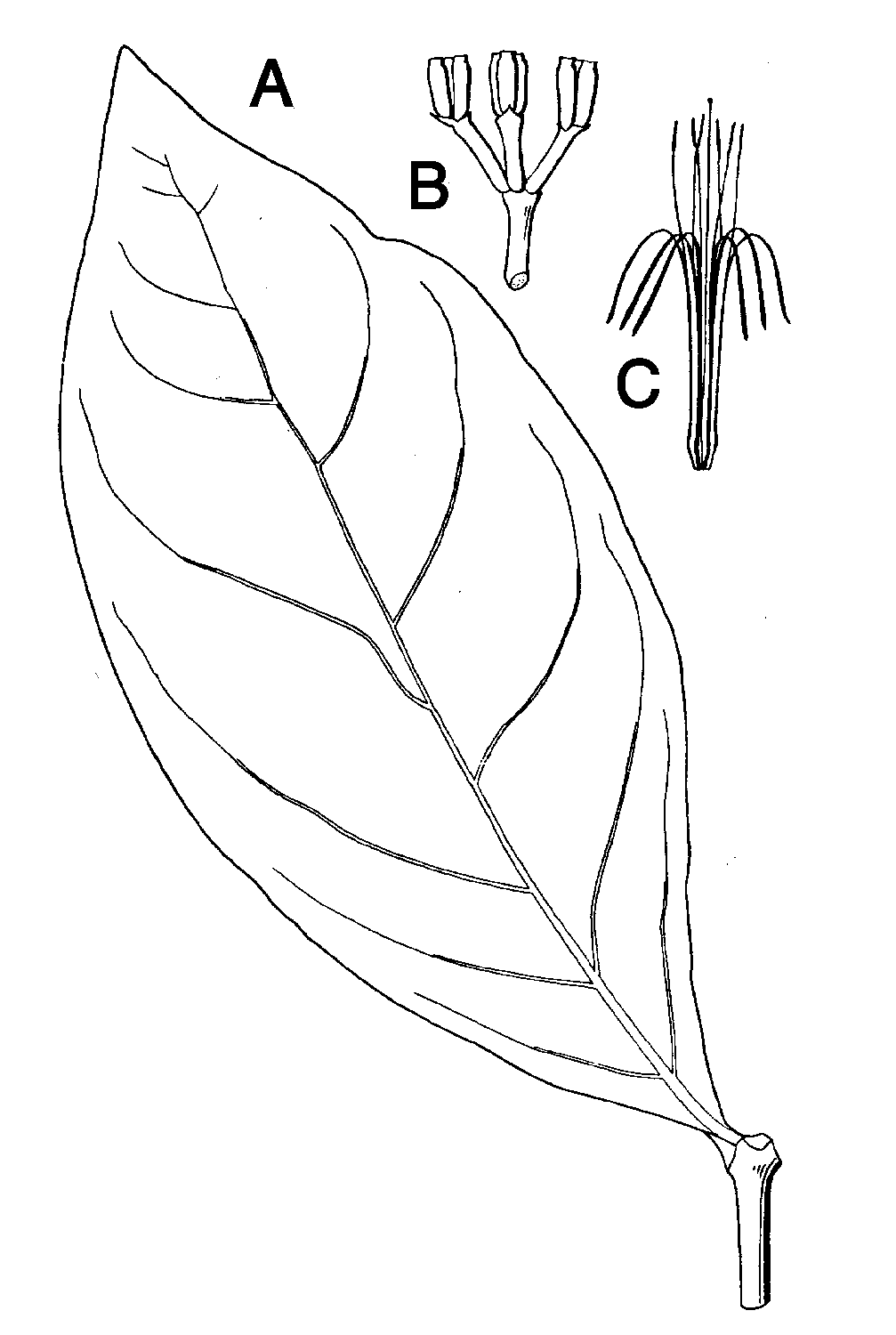
Amyema scandens (as A. cephalanthera). An intermediate form. A - tip of twig with leaf. B - inflorescence. C - corolla with stamens. From Danser (1936, Brittonia 2:131-134).
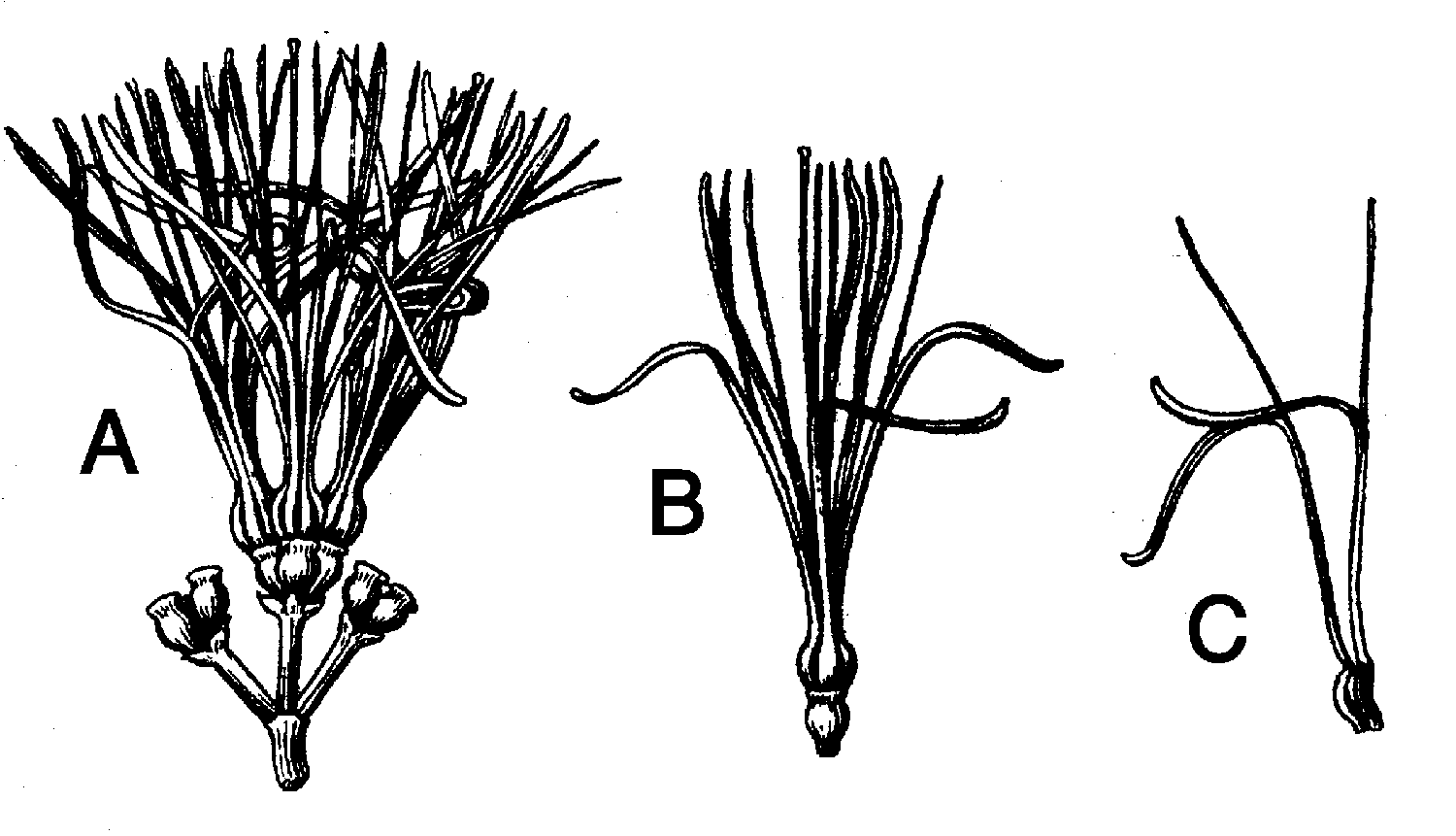
Amyema scandens (as A. caudiciflora). An intermediate form. A - inflorescence. B - flower. C - two petals with stamens. From Danser (1931).
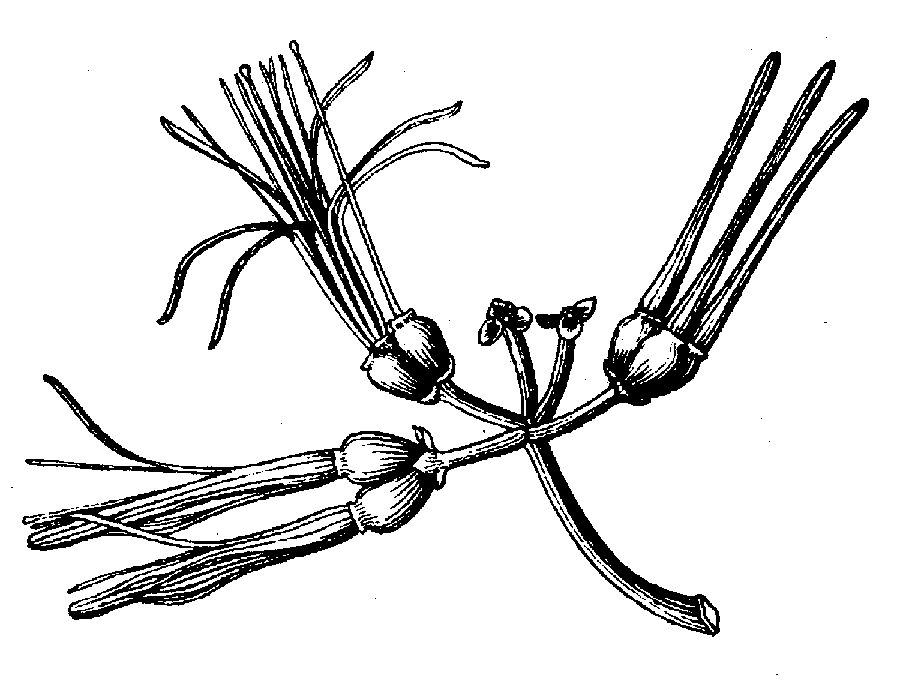
Amyema scandens (as A. ovariosa). Inflorescence. From Danser (1931).
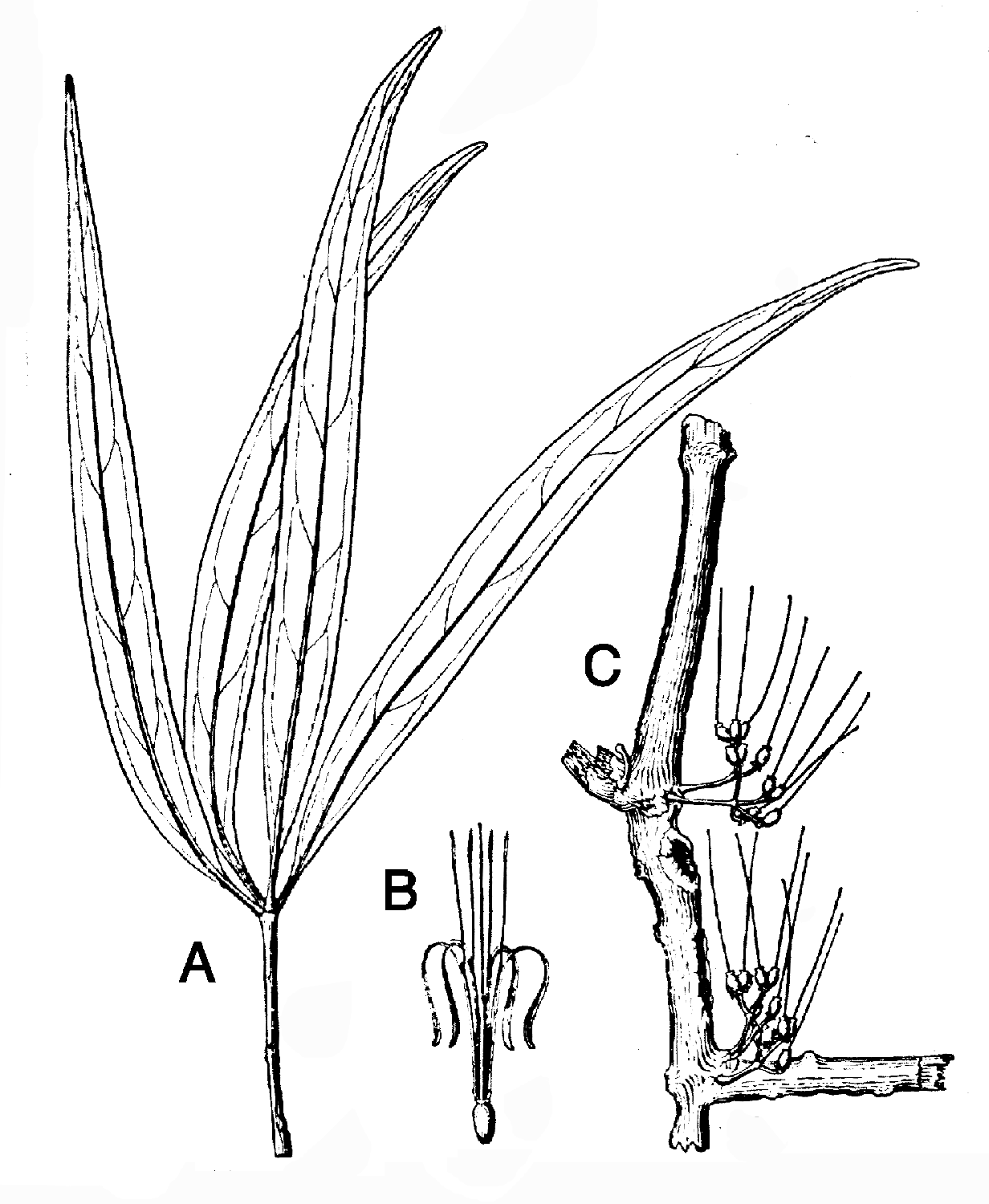
Amyema scandens ssp. scandens (as A. verticillifolia). A - extremity of a twig with leaves. B - flower, of which two petals have been removed. C - older, flower-bearing twig. From Danser (1931).
Photographs
Amyema scandens ssp. scandens. New Caledonia. Photo by Lytton Musselman.
Amyema scandens
updated 18 January 2007